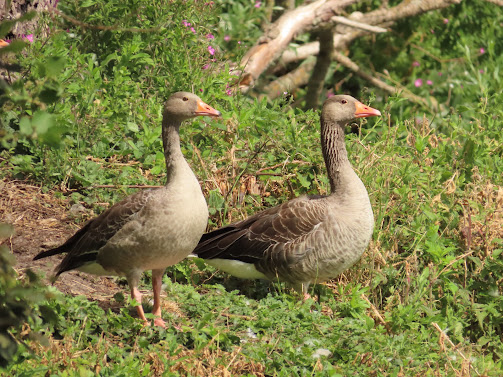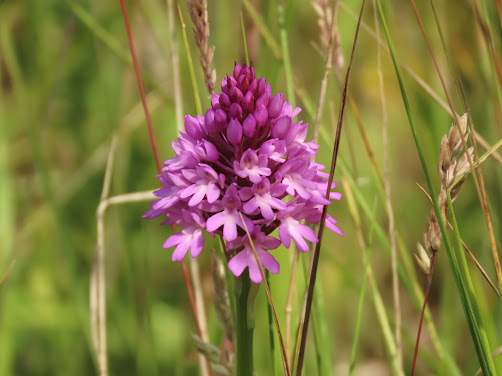With climate meltdown upon us the Patch has groaned under the weight of both drought and high temperatures. The vegetation turned brown, water dried up from the ground and the crops nearly failed. When a green and pleasant land is forced to bear the weight of this hardship, then something must be wrong with the world. I don't think there was any rain in this period, just oppressive heat, which has taken its toll on the area. How much time we have left until things become serious, I'm not sure, all that is evident is that something bad is happening now.
A permanent feature of the Patch are the resident pair of BUZZARDS in the Suffolk Punch Field. Close by were a pair of CROWS. Both are big birds at the top of their food chain, and both sets of birds would tussle in the air whenever the other came close to their breeding area. I don't think the buzzards were successful in breeding this year, as I didn't see any young. This doesn't matter too much as they are long lived birds, so are able to raise many young over their lifetime. Every time I visit they are always there soaring over the fields with their broad round wings, kings and queens of all they survey.
Bird-wise nothing unusual was seen on the Patch, just the usual breeding birds, those found in the general countryside. One of the important birds of the area are YELLOWHAMMERS, beautiful, chubby yellow birds, with their "little bit of bread and no cheese" song. Large flocks used to winter here, but none have done for a while, and this Spring there were few. However over the Summer six territories were found, which is only one less than last year, which is fine, not a large drop. This is still a common bird of the countryside, so they can easily recolonise form elsewhere, but I would still like to see them on the Patch.
Despite the oppressive weather it seems to have been a good breeding season, and by the start of July TIT flocks were in evidence, with young birds in abundance. A young SONG THRUSH was in River Meadow, young WRENS in several places and on the Reservoir a brood of three ugly MOORHEN chicks were in evidence with their attentive parents. Quite unusual, as there aren't any shooting estates in the area, was a brood of RED LEGGED PARTRIDGES wandering down Old Norwich Road, a bird that waxes and wanes, the first evidence of breeding for me for four or five years.
A feature of the Patch in bygone years was the flock of resident GREYLAG GEESE with eight or so present by the Pond, but never breeding. These birds disappeared several years ago, but on 9/8 twenty were present on the Reservoir, the first for several years, but a week later had gone. CORMORANTS are quite rare so one on the Reservoir on 13/8 was a nice record, primeval looking birds, they are truly the descendants of dinosaurs.
The Reservoir is a good place to see the SWIFTS and HOUSE MARTINS that nest in the the nearby Rise Hall and farm buildings, hawking high over the water to catch an unwary insect in the air. Its good that they still cling on here as they've become nearly extinct in nearby Ipswich, the skies becoming silent.
Over the Summer the flower I most delight in experiencing is the PYRAMMID ORCHID, with two colonies on the Patch. In the First Field the colony developed on set aside, left fallow four years ago. Since then it has grown from strength to strength with at least two thousand spikes in flower this year, and the colony is spreading into the main field and expanding. The only problem is that usually when a farm field next to buildings is left to go fallow it means the field is going to be built on. To lose such a large colony when our countryside is so lacking in a friendly environment is a sad thing indeed. The other colony is smaller, but has been there since I started visiting the Patch ten years ago, I call it the Orchid Patch, and this year it also had a good crop. Also in the First Field there is a small stand of VIPER'S BUGLOSS, a tall blue flower, with truly a great name, it flowers there every year, ten or so plants sticking above the surrounding grass.
Otherwise wildflowers are finding it difficult to find a foothold on the Patch, relegated to the field edge, the area of rough ground that escaped the plough. Its been years since there's been a poppy field, the only flowers are those found on the grass verge of Old Norwich Road. The meadows are full of grasses but not many flowers, poisoned by herbicides sprayed by disinterested keepers of the land.
By the end of the period all the crops have been harvested, the meadows mown. The Pond has been excavated, making it deeper, as pretty much the entire year it has been bone dry, due to the drought. The stream, a long drainage ditch, has by this time rune dry to a stagnant puddle. So the only bit of water is the Reservoir, used for irrigation, surrounded by trees, its home to large carp that occasionally break the surface in little ripples.

















No comments:
Post a Comment